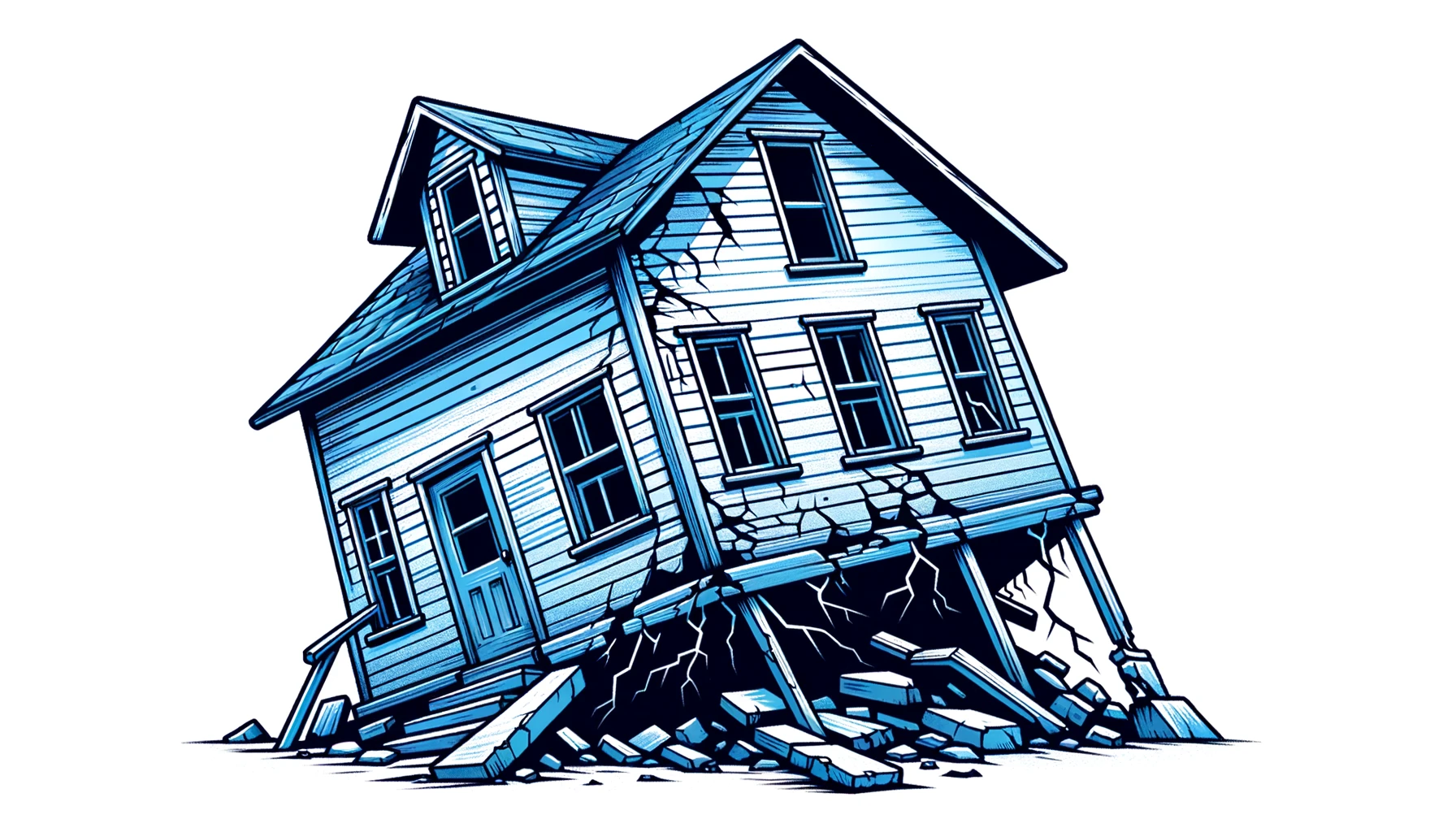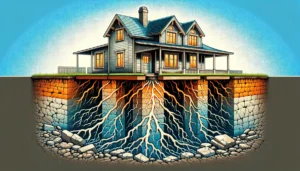A sinking foundation is a serious issue that requires prompt attention. As the very structure that supports your home starts to fail, extensive repairs may be needed to prevent devastating damage. This article will guide you through understanding why foundations sink, recognizing telltale signs, getting an accurate diagnosis of the problem, evaluating effective repair methods, and protecting your most valuable investment – your home.
What is a Sinking Foundation and Why You Should Be Concerned?
In this article, we’ll cover:
ToggleA sinking, or settled, foundation occurs when the foundation of a home shifts downward from its original position. This movement can result from factors like poor soil compaction, erosion, shrinking and swelling soils, or water damage. As the foundation settles, the weight of your home pushes it further out of alignment, causing sloping floors, cracks in walls and ceilings, and misalignment of doors and windows.
If left unaddressed, a sinking concrete slab or block foundation will continue to displace downward, placing immense stress on the structure it supports. The severity of the problem will intensify over time and can lead to destabilization, collapse, and potentially complete loss of the home’s foundation. Catching and repairing foundation issues early is key to preventing catastrophic damage and very expensive repairs down the road.
What Causes Foundation Sinking?
There are several common causes for foundation settlement problems:
- Poor Soil Compaction – Improper compaction when the foundation was originally poured leaves empty pockets of air underneath the concrete slab. When weight bears down, these voids collapse.
- Water Damage and Poor Drainage – Water saturation compromises soil strength and stability. Improper drainage or leaky pipes/gutters allow water to penetrate under and around the foundation, eroding soil and creating channels.
- Expansive Soil – Certain types of clay soils greatly expand and contract with changes in moisture content. During droughts, the drying soil shrinks away from the foundation; in periods of heavy rain, expanding soils push up against the foundation unevenly.
- Nearby Construction – Digging for new structures disturbs and displaces soil, causing uneven settlement. Heavy equipment also sends damaging vibrations through the ground.
- Large Trees – Tree roots growing under foundations crack concrete and drain moisture from the soil, causing destabilization and uneven movement.
- Erosion – Water erosion under foundations is an extremely common problem. Saturation washes away fine particles of soil that provide foundational support.
- Time and Structural Load – Over decades of use, the weight of the structure itself can cause foundations to displace out of level.
Recognizing Warning Signs of Foundation Issues
Catching foundation problems in their early stages is critical for effective repairs. Warning signs include:
- Cracks in Walls or Ceilings – Hairline cracks first appear in interior drywall above doors/windows. As sinking progresses, larger jagged cracks form in exterior brick walls and foundations.
- Sticking or Off-Track Doors/Windows – Displacement from the original frame causes sticking and difficulty opening.
- Uneven Floors – Floors slope visibly downward or feel uneven underfoot as support fails.
- Gaps Between Floors/Walls/Ceilings – Gaps appear as the structure shifts out of alignment. Baseboards/moldings separate from walls, ceilings sag, and doors no longer close properly.
- Bowing Walls – Interior or exterior brick bows inward as the foundation drops out from underneath.
- Foul Sewer Odors – Broken underground pipes leak sewage gases inside.
- Mold Growth – Tilted floors and foundation cracks allow moisture intrusion ideal for mold.
Don’t ignore small holes in drywall or slight sticking of doors. These are often the only early clues of sinking before substantial structural damage arises. If you suspect foundation issues, have your home’s foundation inspected by a structural engineer or foundation repair contractor right away.
Getting a Professional Structural Assessment
While symptoms may indicate foundation problems, only a qualified structural engineer can diagnose the possible causes and severity. The engineer will inspect both inside and outside the home, checking for levelness, alignment, and cracks. High-tech tools like laser levels and ground radar help pinpoint problems. Common diagnostic tests include:
- Elevation Survey – Precisely measures foundation elevation and displacement.
- Soil Analysis – Evaluates composition, moisture content, and stability around the foundation.
- Camera Inspection – Snake cameras through pipes/drains to check underground damage.
- Hydrostatic Testing – Measures underground water pressure on the foundation.
An accurate diagnosis identifies factors causing foundation failure so the most effective solution can be engineered. Never attempt do-it-yourself foundation repairs as this can further destabilize the sinking structure.
Methods for Repairing Sinking Foundations
Once the causes have been determined, a structural engineer will design a custom repair strategy. Proven methods for lifting, stabilizing, and leveling sinking foundations include:
Foundation Piers
Foundation piers are systems of hydraulic jacks anchored to the bedrock beneath problem areas. As jacks steadily raise and re-level the foundation, supports are installed to keep it elevated. Three pier systems are most common:
Push Piers – Steel push piers are driven into firm soil with a hydraulic ram. As pressure is applied, the piers lift and stabilize the foundation.
Helical Piers – Screw-like helical piers are wound into load-bearing soil for lifting power and tension resistance against shifting.
Slab Piers – Concrete is poured into shafts beneath the slab, then lifted with hydraulics. The cured concrete piers permanently support the foundation.
Mudjacking
Mudjacking involves pumping an earth/concrete slurry underneath the slab to fill voids and raise settled areas. Once cured, new solid support is established.
Polyurethane Injections
Expanding polyurethane foam is injected through small holes to fill beneath slabs, gently elevating the foundation as the foam cures in place.
The best solution for a sinking foundation depends on factors like budget, home construction, and soil conditions. Getting professional recommendations is key to long-lasting repairs.
Preventing Foundation Settlement
While foundations naturally settle a little over time, most severe sinking issues arise from preventable causes. Here is how to safeguard your home’s foundation:
- Maintain positive drainage sloping away from the structure
- Use downspout extensions, French drains, etc. to divert rainwater
- Water trees/shrubs at the drip line, not close to the foundation
- Avoid planting trees with aggressive root systems near the foundation
- Keep gutters and downspouts clear of debris
- Repair leaky pipes, faucets, and toilets promptly
- Maintain relatively consistent soil moisture with irrigation systems
- Have the foundation inspected every 2-3 years
Addressing minor issues promptly, like small exterior cracks or soil erosion, can make a big difference in preventing major foundation damage.
What Does Foundation Repair Cost?
The costs involved in fixing a sinking foundation vary widely depending on factors like:
- Size of home
- Number of piers required
- Extensiveness of damage
- Special site considerations
Minor sinking foundation repair projects often run $5,000 to $10,000. Extensive repairs with foundation piers can cost between $10,000 to $25,000. In cases of severe structural damage or large luxury homes, repairs can exceed $100,000.
Many homeowners utilize home equity loans to finance major foundation work. Permanent house foundation repairs also increase property value more than the cost of the repairs themselves. Some insurance policies cover foundation damage; check with your provider about your coverage options.
How to Choose the Right Contractor

Because foundation repairs are intricate and costly, it is essential to hire a reputable, specialized contractor with extensive experience, proper licensing, and workers’ compensation insurance. Warning signs when choosing contractors include:
- Reluctance to provide customer referrals
- No facility you can visit to view past work
- Lack of liability insurance and bonding
- Quotes substantially lower than competitors
The right contractor will offer a lifetime warranty on foundation piers backed by a sufficient corporate guarantee – a sign they stand behind their work. They will also provide a detailed proposal outlining the recommended methods and costs for repairs.
Local Foundation Repair Services in Dallas-Fort Worth
If you’re based in the Dallas-Fort Worth area, you’re in luck when it comes to finding expert foundation repair services. At Portman Foundation Repair, we’re proud to extend an exclusive offer to our local community — completely free estimates and detailed foundation inspections.
Our team is comprised of highly skilled foundation repair specialists, each bringing a wealth of expertise, state-of-the-art equipment, and over 20 years of experience to the table. This combination ensures that we can accurately diagnose any issues with your foundation and propose effective, lasting solutions.
Whether you’re facing minor cracks or significant foundation settlement problems, our experts are equipped to handle challenges of all scales. By choosing Portman Foundation Repair, you’re opting for a service that not only identifies the root cause of the problem but also provides a permanent solution, safeguarding your property’s integrity and value.
Take Action at the First Sign of Trouble
Dealing with a sinking foundation can be an overwhelming and expensive ordeal. However, ignoring the problem will only lead to exponentially worsening destruction of your home. Early intervention is key – at the first signs of foundation damage, take action by contacting foundation repair experts. An accurate diagnosis of the causes will set you on the path to protecting your home investment with the right stabilization and lifting methods. With some diligence to prevent future foundation issues, you can have peace of mind knowing your entire home has a solid base standing firmly in place for decades to come.



